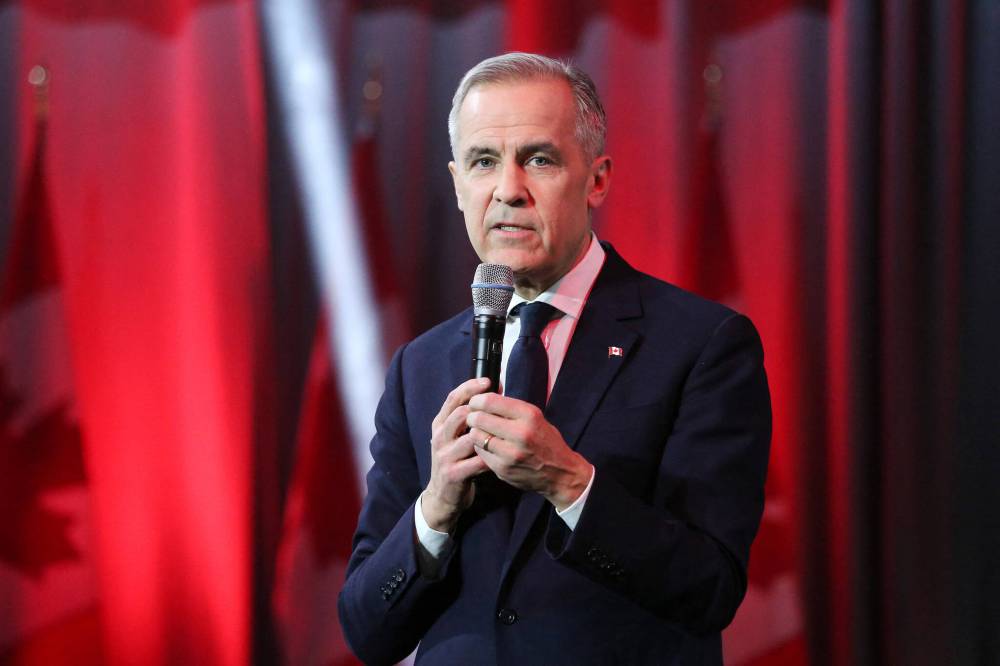Mark Carney takes reins with a pared-down cabinet
Advertisement
Read this article for free:
or
Already have an account? Log in here »
To continue reading, please subscribe:
Monthly Digital Subscription
$0 for the first 4 weeks*
- Enjoy unlimited reading on winnipegfreepress.com
- Read the E-Edition, our digital replica newspaper
- Access News Break, our award-winning app
- Play interactive puzzles
*No charge for 4 weeks then price increases to the regular rate of $19.00 plus GST every four weeks. Offer available to new and qualified returning subscribers only. Cancel any time.
Monthly Digital Subscription
$4.75/week*
- Enjoy unlimited reading on winnipegfreepress.com
- Read the E-Edition, our digital replica newspaper
- Access News Break, our award-winning app
- Play interactive puzzles
*Billed as $19 plus GST every four weeks. Cancel any time.
To continue reading, please subscribe:
Add Free Press access to your Brandon Sun subscription for only an additional
$1 for the first 4 weeks*
*Your next subscription payment will increase by $1.00 and you will be charged $16.99 plus GST for four weeks. After four weeks, your payment will increase to $23.99 plus GST every four weeks.
Read unlimited articles for free today:
or
Already have an account? Log in here »
Hey there, time traveller!
This article was published 18/03/2025 (249 days ago), so information in it may no longer be current.
Mark Carney unveiled a pared-down cabinet as his first order of business after being sworn in as Canada’s 24th prime minister on Friday.
His second major decision as the new prime minister was to immediately eliminate the consumer carbon tax imposed by his predecessor, Justin Trudeau, who tendered his resignation earlier that day during a visit to Gov. Gen. Mary Simon.
It’s not unusual for a new prime minister to select a smaller cabinet, one that is easier to manage and can be expanded over time. But these are not usual times. Carney is expected to call a federal election within days, likely before Parliament is scheduled to resume on March 24.

Tribune News Service
Prime Minister Mark Carney
While the newly sworn-in ministers will remain in place during the election campaign, it could be one of the shortest-lived cabinets in Canadian history if the Liberals are defeated in the upcoming election.
Still, Carney’s cabinet choice will play an important role in Canada’s No.1 priority right now: how to deal with an unpredictable and hostile president south of the border.
U.S. President Donald Trump continues to muse about wanting Canada to become a “51st state” and is showing no signs of backing down on imposing a series of punishing tariffs against Canada and other trading partners.
It was no surprise, then, that Carney opted for continuity by keeping in place the core group of cabinet ministers who have been meeting with U.S. officials in recent weeks to try to convince the Trump administration to reverse its decision on tariffs.
Mélanie Joly will stay on as minister of foreign affairs and has been given the added responsibility of international development. Dominic LeBlanc retained his cabinet post as minister of intergovernmental affairs, while taking on international trade and president of the King’s Privy Council.
François-Philippe Champagne, also a core minister on the U.S. file, becomes finance minister and Anita Anand was named minister of innovation, science and industry.
Conspicuous in its absence was proper representation from the West. Carney opted for only two cabinet ministers from Western Canada, including one from Manitoba (Terry Duguid, minister of the environment) and one from British Columbia (Jonathan Wilkinson, minister of energy and natural resources).
Granted, the Liberals have no MPs in Saskatchewan and only two in Alberta. However, selecting only two cabinet members from all of Western Canada fails to give that part of the country the cabinet representation it deserves. It will also not help Liberal fortunes in the West in the upcoming election.
What may help Carney win seats in the West and elsewhere is his decision to eliminate the consumer carbon tax, a pledge he made during the Liberal leadership campaign. The move was more about good politics than good policy, as it removes one of the key wedge issues between the Liberals and Conservatives.
Conservative Leader Pierre Poilievre made the carbon tax one of his main targets against the Liberals through his “axe the tax” campaign and his references to Carney as “Carbon Tax Carney” (a Trump-like political tactic that may backfire on the Tories given the current Canada-U.S. political climate).
Carney says he will keep the carbon tax for industrial emitters, but will find other ways of reducing greenhouse gases when it comes to consumers. The Liberals say they are still committed to fighting climate change.
However, it remains to be seen what specific alternatives they will propose in the absence of a price on carbon for consumers.
Presumably, Canadians will find that out in the upcoming election, a contest that will be like no other, as the country’s newest prime minister and his leaner cabinet face the most serious threat from a U.S. government in recent history.
History
Updated on Tuesday, March 18, 2025 6:41 AM CDT: Fixes byline





